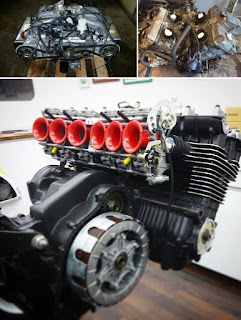Monday, November 23, 2015
The Four Stroke Exotic Engine : V-Fours, Inline Six & Flat-Six !

The V-Fours (V4) Engine
When Honda introduced its water-cooled V-four engine bikes for the 1982 model year, pundits predicted the demise of the inline four. It seemed reasonable at the time. These engines have exceptional power characteristics, providing good torque figures and more than adequate horsepower. Plus they are one of the smoothest engine designs in existence.
This engine design has become something of a standard - powering a variety of sportbikes, cruisers, and touring bikes - but it never came close to replacing the inline four. That was probably due to the expense of manufacturing such a complex engine design rather than any inherent flaws with the concept. In service, these have proven to be remarkably reliable motorcycles.
" A V-four engine is an engine with four cylinders arranged in a V-shaped configuration."
If you are in the market for a used motorcycle, a bike with a V-four engine is a safe bet. These bikes have been nearly indestructible. I have a friend who has 125,000 miles on his 1985 Honda 700 Magna as I write this. By the time you read it, he will probably hit 150,000 miles.
Inline Six Engine
For a few years in the mid-1970s and early 1980s, a few manufacturers fooled around with inline six-cylinder motorcycle engines, but these proved to be oddities, footnotes in the motorcycle history books. The odds of you stumbling across one of these beasties by chance are slim; most such machines are now the property of collectors.
"An inline six-cylinder engine is an engine with six cylinders in a row."
The Italian company Benelli produced a 750cc six-cylinder bike, but like many Italian bikes, this is one you’ll probably only see in pictures. More common were the big Sixes produced by Honda and Kawasaki. These were functional motorcycles, but both were victims of their own excess. The width of those six-cylinders just proved to be more bulk than would comfortably fit down in the engine bay, and handling suffered, especially on the water-cooled Kawasaki, which weighed nearly as much as a small car. And if four-cylinder engines are complex to maintain, sixes are absolute nightmares.
The Gold Wing - Flat-Six Engine
The engine Honda uses in its Gold Wing touring bikes is so unique, it doesn’t fit into any other category. The only thing comparable to the same inline six-cylinder version is the engine Porsche's uses in its 911-series. This is a flat, Boxer-type engine, with four or six liquid cooled cylinders, rather than two air-cooled cylinders, like BMW uses. The flat-four and flat-six-cylinder engines used in Honda’s Gold Wings are called flat because their cylinders are arranged in a flat, opposing configuration.
"When Honda introduced its Gold Wing in 1975, it created a new class of motorcycle : the luxury tourer."
These are the smoothest engines used in motorcycles, period, and are a major part of the Gold Wing’s appeal to the touring crowd. They also have a fairly centralized mass, which makes the entire motorcycle easier to maneuver. I’ve seen Gold Wing riders whip their bikes around as if they were riding sportbikes instead of ultimate behemoths weighing twice what the average sportbike weighs.
Subscribe to:
Post Comments (Atom)

No comments:
Post a Comment